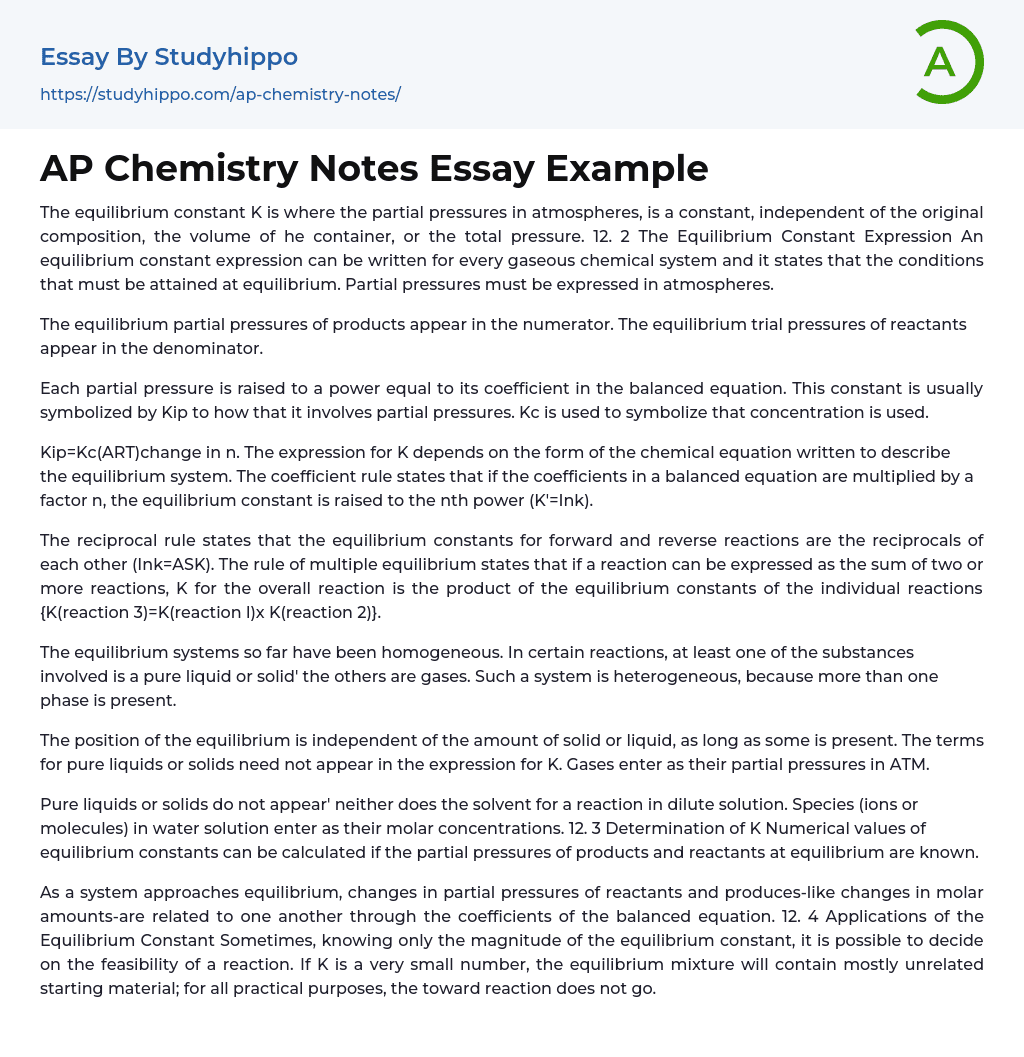The constant equilibrium constant K, which is a function of the partial pressures in atmospheres, remains constant regardless of the initial composition, container volume, or total pressure of a gaseous chemical system. An equilibrium constant expression must be written for every gaseous chemical system and specifies the conditions required to attain equilibrium, where partial pressures are expressed in atmospheres. In the numerator of the equilibrium constant expression are the equilibrium partial pressures of products, while in the denominator are the equilibrium trial pressures of reactants. Each partial pressure's exponent corresponds to its coefficient in the balanced equation and is denoted by Kip for partial pressure and Kc for concentration. The constant Kip is symbolized as Kc(ART)change in n and can differ depending on the form of the chemical equation describing the equilibrium system. The coeffi
...cient rule dictates that multiplying a balanced equation's coefficients by a factor "n" will raise the equilibrium constant to its nth power (K'=Ink). Conversely, the reciprocal rule states that forward and reverse reaction equilibrium constants are reciprocals of one another (Ink=ASK).
The principle of multiple equilibrium states that the overall equilibrium constant (K) for a reaction that can be expressed as the combination of two or more reactions is equal to the product of each individual equilibrium constant (K(reaction 3)=K(reaction l)x K(reaction 2)). This principle applies to homogeneous equilibrium systems. However, for some heterogeneous reactions, at least one substance involved is a pure liquid or solid, while the others are gases, resulting in a system with multiple phases or states. The position of equilibrium remains unchanged irrespective of the amount of solid or liquid present, and pure liquids or solid
do not need to be included in the expression for K. Gases are represented by their partial pressures in ATM while species in water solution are represented by their molar concentrations. The numerical value of equilibrium constants can be calculated using the partial pressures of reactants and products at equilibrium, and any changes in these values as the system approaches equilibrium are linked through the balanced equation coefficients. Finally, it is possible to determine the feasibility of a reaction knowing only the magnitude of the equilibrium constant.If K is very small, the equilibrium mixture will contain mostly starting material and the reaction will not go in practical terms. If K is large, the reaction will produce products in high yield. In cases where K has an intermediate value, quantitative calculations must be made regarding the direction or extent of the reaction. The reaction quotient, Q, has the same expression as the equilibrium constant, K, but with partial pressures at a specific moment, not necessarily at equilibrium. By comparing Q to K, the direction in which the system will move to achieve equilibrium can be determined. The equilibrium constant can be used to calculate the partial pressures at equilibrium. Changes to external conditions can disturb equilibrium by adding or removing gaseous reactants or products, compressing or expanding the system, and changing temperature.
Applying Eel Chatterer's principle, the direction of an equilibrium shift can be inferred when changes in concentration, pressure, or temperature are made. If a gaseous species is added, the reaction will proceed to consume it, while removal of a gaseous species will cause the system to restore that species. Adding or removing a pure
liquid or solid has no effect on equilibrium. To shift the position of an equilibrium, a species must appear in the expression for K. When total pressure is increased by compression, the reaction occurs in the direction that reduces the number of gas moles, whereas a decrease in pressure due to expansion causes a shift in the opposite direction to increase gas moles.
- Oxygen essays
- Atmosphere essays
- Coral Reef essays
- Desert essays
- Earth essays
- Ocean essays
- Lake essays
- Sea essays
- Biodiversity essays
- Natural Environment essays
- Forest essays
- Soil essays
- Water essays
- Rainbow essays
- Ecosystem essays
- Volcano essays
- Wind essays
- Forestry essays
- Bottled Water essays
- Acid essays
- Calcium essays
- Carbohydrate essays
- Carbon essays
- Chemical Bond essays
- Chemical Reaction essays
- Chemical reactions essays
- Chromatography essays
- Concentration essays
- Copper essays
- Diffusion essays
- Ethanol essays
- Hydrogen essays
- Organic Chemistry essays
- Osmosis essays
- Periodic Table essays
- Ph essays
- Salt essays
- Sodium essays
- Titration essays
- Air Pollution essays
- Carbon Dioxide essays
- Climate essays
- Deforestation essays
- Ecology essays
- Endangered Species essays
- Environmental Issues essays
- Environmental Protection essays
- flood essays
- Greenhouse Gas essays
- Hurricane essays




